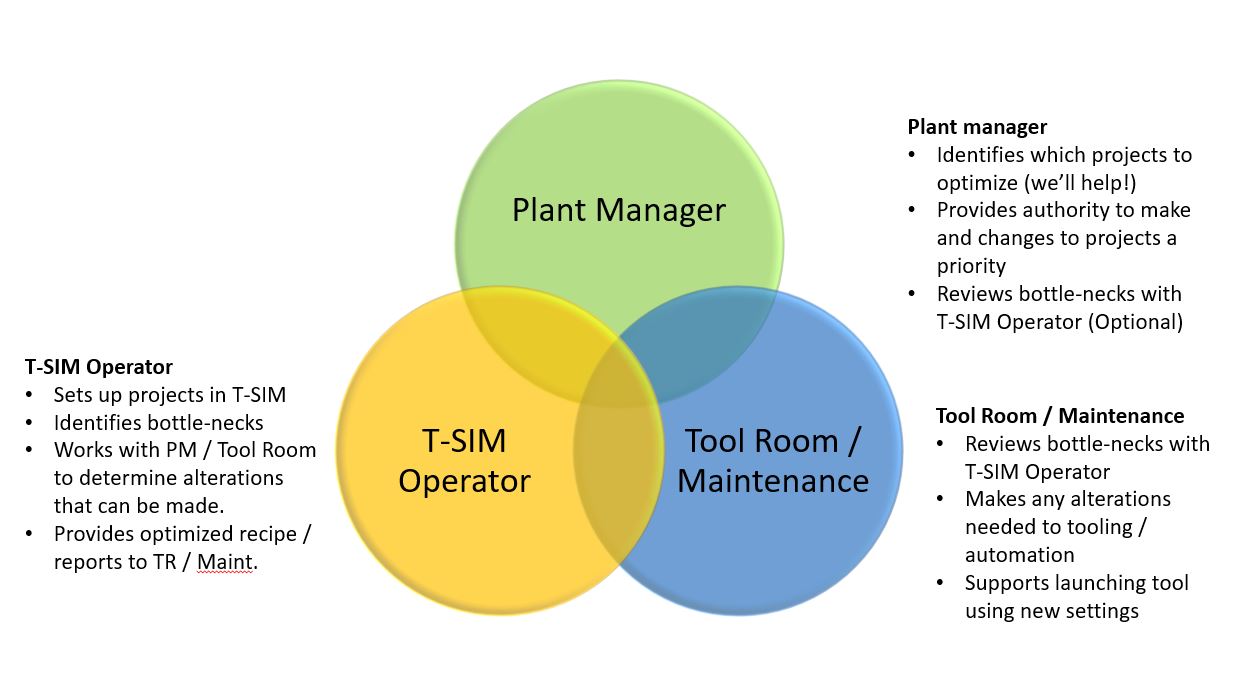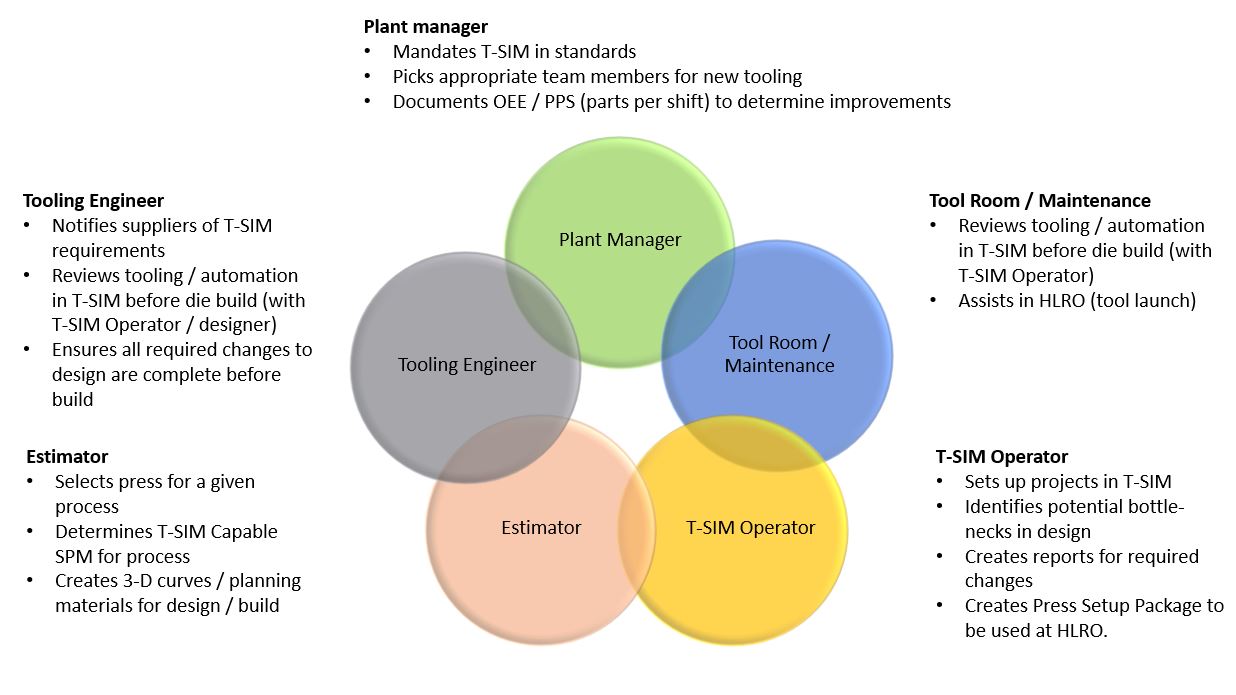How to Create a T-SIM Team
Your T-SIM team structure will be very dependent on how you wish to utilize T-SIM Software.
If you are just testing the waters and would like to have our service department optimize some existing tools, we still recommend having a T-SIM team to start, but it will be a small group. Really, we just need to work with a few individuals from the organization who can provide the following information and/or perform the following tasks:
Provide information:
- Basic press information and specs
- CAD data of the die design (for each job)
- A few pictures of the physical tooling/automation (if applicable)
At the press:
- Provide a tooling summary (what happens when the job is ran faster)
- Confirm a few measurements at the press
- Input newly optimized T-SIM start and stop angles
- Use T-SIM Press Room Version for any fine tuning (if applicable)
Once the T-SIM press model is created, only job specific information is required and once you see the results, you can use T-SIM software internally to further simplify the process (since you have easier access to the physical tooling & press line in the plant.
Most T-SIM Software Customers have teams that look like this:
Existing Tool Optimization Team
- Plant Manager
- T-SIM Operator (or T-SIM Service team member)
- Tool Room/Maintenance

New Tool Simulation and Optimization Team
- Plant Manager
- Estimators
- T-SIM Operator (or T-SIM Service team member)
- Tooling Engineers
- Tool Room/Maintenance

Depending on the T-SIM operator skillsets and experience, we also have customers that take a hybrid approach and have an intern who setups up the jobs in T-SIM using design CAD and then they have a more experienced employee (Plant manager, tooling engineer, or tool room / maintenance member) who helps to review, optimize, and educate the intern on what can or can’t be modified in the tooling easy enough. We’ve had several customers have great success using this method.
See below to learn about who makes the best T-SIM users or what skillsets are required to make up a T-SIM team.
T-SIM Operator (CAD) Team Member:
This team member should be able to open and manipulate CAD models, have a basic understanding of tooling and, be able to work well with the other team members. It’s not unusual for this position to be filled by one of the other team members who either has some CAD experience or is interested in developing that skill as part of their capabilities.
If hiring new team member – Download our generic T-SIM position description (If these requirements are met, they can go through T-SIM Trainings and be good to go.)
If promoting internal staff into a new role, here are some tips for which team members transition the fastest and/or most successful.
Press operators
Press operators are up close and personal with the equipment on a day-to-day basis. They often understand the capabilities and limitations of the press line better than most others in the organization. They know how to program the transfer, adjust automation, and trouble-shoot issues during production. Many feel that the press line is “their baby” and are personally vested in it performing well. These characteristics make them great T-SIM operators.
Tool / Die makers (journeyman or apprentice)
Knowing what can and cannot be done in a tool is an important part of optimizing projects. You never want to suggest changes that can compromise the integrity of the tooling or automation. The added benefit of a Journeyman die maker running T-SIM is they can often perform needed changes to the tooling themselves and understand what cost would be involved in a suggested change to consider its viability.
Maintenance Team Members
Different companies label these departments differently so, to clarify, this team member is the person who typically programs the press / transfer system the first time a new project is set up and adjusts programs as needed if any issues are encountered. They typically have access to all equipment settings, are very familiar with all the equipment in the press line (FOL, EOL, Shuttles, etc.), and have a good understanding of grippers & automation being used in the plants. Like the press operators, maintenance personnel typically know the press lines very well and understand its capabilities and limitations. They also often have a desire to reduce equipment wear and tear which fits hand in hand with using T-SIM. All of these reasons make this person an ideal candidate to use T-SIM Software.
Plant Managers
Plant managers make amazing T-SIM software users and typically have the power to make decisions on the fly and implement changes immediately. The only issue is that they are typically far too busy to use T-SIM software daily so if you are a plant manager who wants the data, consider the hybrid approach. Find yourself an intern, put them through the T-SIM training program and have them load up jobs to review with you.
Estimators
Person responsible for new tooling quoting. Not as obvious a choice as you might first think but, estimators are often very familiar with tooling and production equipment. They have to review incoming parts, determine an approximate process, and try to figure out what a reasonable production rate could be if they are awarded the part by the manufacturer. Most of these assessments rely on their past experience, prior projects, and sometimes, just gut feelings (not ideal but real). Their skill sets make excellent T-SIM operators. With T-SIM training, they can be equipped to use T-SIM software to select the best press for a part, confirm the process feasibility, and create an optimized curve to provide a very accurate SPM to base the estimate on. If you're awarded the project, that “pre-work" done in estimating can be the starting point for kicking off the project to your suppliers. This ensures a great start and the highest probability of success with your projects.
Tooling Engineers
Many tooling engineers have experience with both tooling and presses. They often review the dies to ensure they are properly built, adhere to company standards, and will run in the assigned press. Putting T-SIM into their hands gives them a powerful tool to review tooling in a whole new way (dynamically) ensuring they succeed in achieving great quality tools that (most importantly) run at a highly profitable production rate. With the sheer number of tools, design techniques, and underlying knowledge tooling engineers have, they are an obvious fit to use T-SIM Software
Members for thew following departments also make great assets for your T-SIM Team!
Tool Room Team Member:
The Tool Room team member should be someone who is high enough in position that they can determine scheduling and prioritization for potential corrections needed in the tools being optimized. They should have a level of knowledge that would allow them to know if requested changes are feasible (not jeopardizing integrity of the tooling), approximately how long the changes would take, and how much they would cost to complete. Often times this position is filled by journeymen die makers who are either managers of the tooling department or senior enough that their manager will trust their advice and adjust schedules accordingly.
Maintenance Department Team Member:
Different companies label these departments differently so, to clarify, this team member is the person who typically programs the press and transfer the first time a new project is setup and adjusts programs as needed if any issues are encountered.
The person holding this position needs to have permissions to access all equipment settings, should be very familiar with all the equipment in the press line (FOL, EOL, Shuttles, etc.), and have a good understanding of grippers & automation being used in the plants. If a press operator has a problem with something not running properly in the controller, they would call this team member.
Press Operator Team Member:
Good press operators are worth their weight in gold these days and not always the easiest people to come by. A good operator team member should have advanced knowledge of the press(es) they run. They should understand all the little nuances of the press line, the areas they always struggle with (air pressure, sensors, worn out equipment in the line, and any common issues experienced in their piece of equipment. (the bar always shakes if you go too fast in this axis, the press brake is worn and the slide drifts on hard stops more than other press lines, etc.)
In plants with multiple press lines, this position may change as you work from press to press optimizing existing tooling but, the common thread with this position is they are motivated team players who want to learn and run their presses as efficiently as possible.
Increase production rates, Get rid of headaches!
Get inTouch

